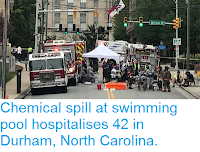Four people have been confirmed dead after Hurricane Florence made landfall in North Carolina on Thursday 13 September 2018. The storm made landfall at Wrightsville Beach in New Hanover County, North Carolina early in the morning, brining with it storm surges in excess of three metres. The four people known to have died in the storm include a mother and child killed when a tree fell on their car in Wilmington, a person killed while trying to connect a generator in Lenoir County and a woman in Pender County who died of a pre-existing medical condition when emergency services were unable to reach her due to a road blocked by fallen trees. In addition the storm left around 700 000 people without electricity, and caused a number of buildings collapsed, including a hotel in Jacksonville in Onslow County, from which a number of people had to be rescued.
Flooding in River Bend, North Carolina, on 13 September 2018, after the Trent River burst its banks during Hurricane Florence. Action News Jacksonville.
Tropical storms are caused by the warming effect of the Sun over tropical seas. As the air warms it expands, causing a drop in air pressure, and rises, causing air from outside the area to rush in to replace it. If this happens over a sufficiently wide area then the inrushing winds will be affected by centrifugal forces caused by the Earth's rotation (the Coriolis effect). This means that winds will be deflected clockwise in the northern hemisphere and anti-clockwise in the southern hemisphere, eventually creating a large, rotating Tropical Storm. They have different names in different parts of the world, with those in the northwest Atlantic being referred to as hurricanes.
The path and strength of Hurricane Florence. Thick line indicates the
past path of the storm (till 3.00 pm GMT on Friday 14 September 2018),
while the thin line indicates the predicted future path of the storm,
and the dotted circles the margin of error at six and twelve hours
ahead. Colour indicated the severity of the storm. Tropical Storm Risk.
Despite the obvious danger of winds of this speed, which can physically
blow people, and other large objects, away as well as damaging buildings
and uprooting trees, the real danger from these storms comes from the
flooding they bring. Each drop millibar drop in air-pressure leads to an
approximate 1 cm rise in sea level, with big tropical storms capable of
causing a storm surge of several meters. This is always accompanied by
heavy rainfall, since warm air over the ocean leads to evaporation of
sea water, which is then carried with the storm. These combined often
lead to catastrophic flooding in areas hit by tropical storms.
See also...
Follow Sciency Thoughts on
Facebook.








